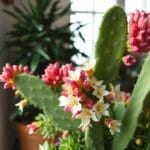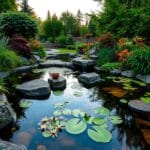Did you know 70% of cherry trees in Washington D.C.’s famous park are Yoshino? This fact shows how popular Japanese flowering cherry trees are in landscaping1. I’m excited to share about these beautiful trees that add color to gardens in the U.S. in spring.
These trees come from Japan and Asia, loved for their delicate flowers and cultural value2. They grow 15-25 feet tall and 13-26 feet wide, ideal for many landscaping projects. Their fast growth rate of 1-2 feet per year makes them great for quick garden changes.
Though they bloom beautifully in spring, these trees only live 15-25 years. Knowing how to care for them is key to enjoying their beauty in our gardens.
In Japan, enjoying cherry blossoms, or hanami, has a long history since the Nara period (710-794)3. This cultural tradition makes Japanese flowering cherry trees even more special. As we learn about caring for Prunus serrulata, we’ll see how to add this timeless beauty to our gardens.
Key Takeaways
- Japanese flowering cherry trees are popular ornamental trees known for spring blooms
- Prunus serrulata typically grows 15-25 feet tall and 13-26 feet wide
- These trees have a fast growth rate of 1-2 feet per year
- They thrive in USDA hardiness zones 5-8
- Japanese flowering cherry trees have a relatively short lifespan of 15-25 years
- Proper care and maintenance are crucial for maximizing their beauty
Introduction to Japanese Flowering Cherry (Prunus serrulata)
The Japanese flowering cherry, or sakura, is a stunning tree that has won hearts around the world. Its delicate blossoms and deep cultural meaning fascinate me. Let’s dive into its history, types, and why it’s a favorite in gardens.
History and Cultural Significance
Sakura trees have a rich history. In 1912, Japan gave 3,020 cherry trees to Washington D.C., starting a beautiful friendship4. This gift led to the National Cherry Blossom Festival, celebrating these trees and cultural exchange.
Bringing cherry blossoms to America wasn’t easy. In 1910, the first 2,000 trees were lost to insects4. But, a new shipment arrived in 1912 with 12 varieties, including the Somei-Yoshino4.
Overview of Prunus serrulata Species
Prunus serrulata, or Japanese cherry, is just one of many cherry blossom types. In the early 1900s, horticulturists like David Fairchild introduced many cherry varieties to the U.S5.. The Yokohama Nursery Company in Japan supplied a wide range of cherry blossoms5.
Popularity in Landscaping and Ornamental Use
Cherry blossoms are now a key part of garden design. Their spring blooms are breathtaking, making them great for garden focal points. From 1913 to 1920, workers planted many cherry tree varieties in Washington D.C.’s parks, enhancing their beauty4.
Today, these trees are still a favorite for both public and private gardens. Their beauty and elegance add a touch of Japanese style to many places.
| Cherry Blossom Variety | Number of Trees (1912 Planting) | Notable Characteristics |
|---|---|---|
| Somei-Yoshino | 1,800 | Most predominant variety, pale pink to white flowers |
| Kwan-zan | 350 | Deep pink double flowers, later blooming |
| Other Varieties | 870 | Various colors and bloom times |
Characteristics of Japanese Flowering Cherry Trees
Japanese Flowering Cherry trees are known for their stunning pink flowers and spring bloom. They come from Japan, China, Korea, and Vietnam. These trees can grow up to 7.9–11.9 meters tall6. Their beauty is breathtaking when they bloom in the spring.
The flowers of Prunus serrulata are truly spectacular. In the wild, they have five white to pink petals6. Through selective breeding, we now have many varieties with different bloom colors and types7. It’s like nature’s own perennial garden, refreshing itself every year.
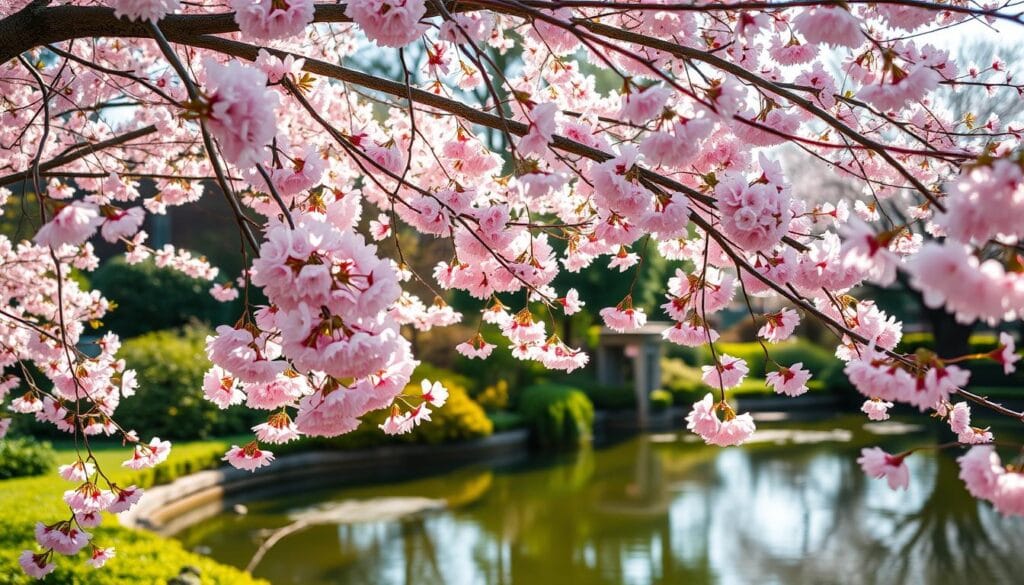
‘Kanzan’ is a popular cultivar with an upright, vase-shaped habit. It has clusters of pink double flowers, each with 20 to 30 petals7. This variety is loved for cherry blossom viewing in Europe and North America, even in colder areas6.
These trees are mainly for decoration, but most don’t bear fruit7. The leaves, stems, and seeds are toxic to pets and humans. So, it’s important to be careful7.
| Characteristic | Description |
|---|---|
| Average Lifespan | 15 to 20 years |
| Flowering Season | Spring |
| Visual Interest | Spring, Summer, Fall |
| Sun Preference | Full Sun |
| Soil Preference | Well-drained, Loamy |
Japanese Flowering Cherry trees love full sun and well-drained, loamy soils. They don’t do well in poorly drained soils. Good air circulation is key to avoid disease7. With the right care, these trees will add beauty to your garden for many years.
Ideal Growing Conditions for Prunus serrulata
Japanese Flowering Cherry trees do best in conditions that match their natural home. I’ll show you the important factors for their growth and beautiful flowers.
Sunlight Requirements
These trees love full sun. They need at least six hours of direct sunlight every day. Planting your cherry blossom in a sunny, sheltered spot is key8.
Soil Preferences
Japanese Flowering Cherry trees prefer well-drained soil that’s rich in nutrients. The best soil mix includes loamy soil for fertility, sand for drainage, and organic matter for extra nutrients. The soil pH should be between 6.7 and 7.1 for the best growth9.
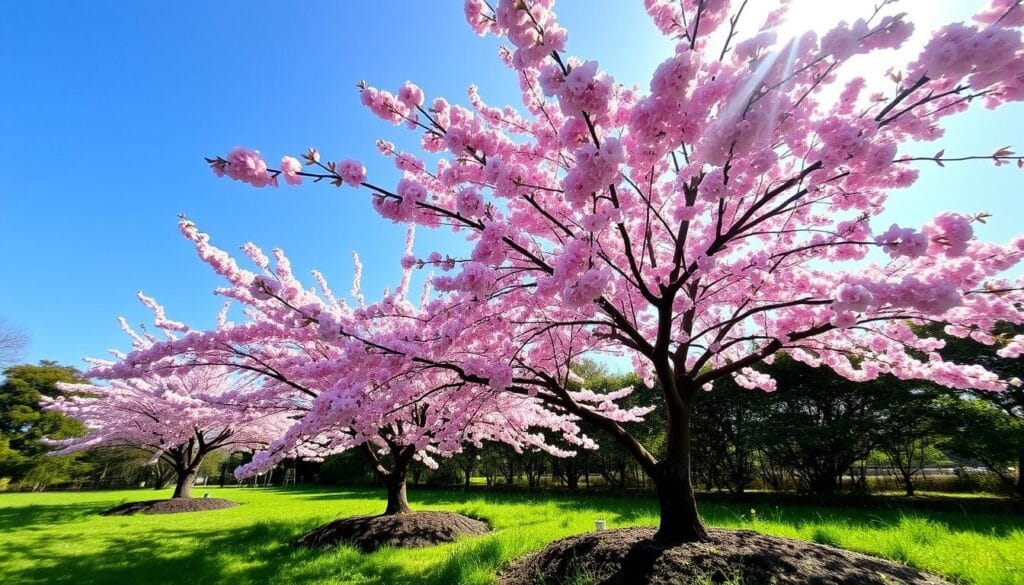
Climate and Hardiness Zones
These trees are best for USDA hardiness zones 5b to 8a. They need a winter to rest and grow well. Japanese Flowering Cherry trees can handle temperatures as low as -10°F but may struggle in cool, wet, and humid summers10.
| Factor | Ideal Condition |
|---|---|
| Sunlight | Full sun (6+ hours daily) |
| Soil pH | 6.7 – 7.1 |
| Soil Type | Well-drained, loamy mix |
| Hardiness Zones | USDA 5b – 8a |
By giving these ideal growing conditions, you’ll have a healthy, blooming Japanese Flowering Cherry tree. It will be the highlight of your garden.
Planting Your Japanese Flowering Cherry Tree
I enjoy planting Japanese flowering cherry trees in early fall or spring. They grow fast, adding 1 to 2 feet each year. This makes them perfect for quick changes in your landscape11.
When picking a spot, I look for at least six hours of sunlight a day. The soil should be well-draining and slightly acidic, with a pH between 6.0 and 7.01213.
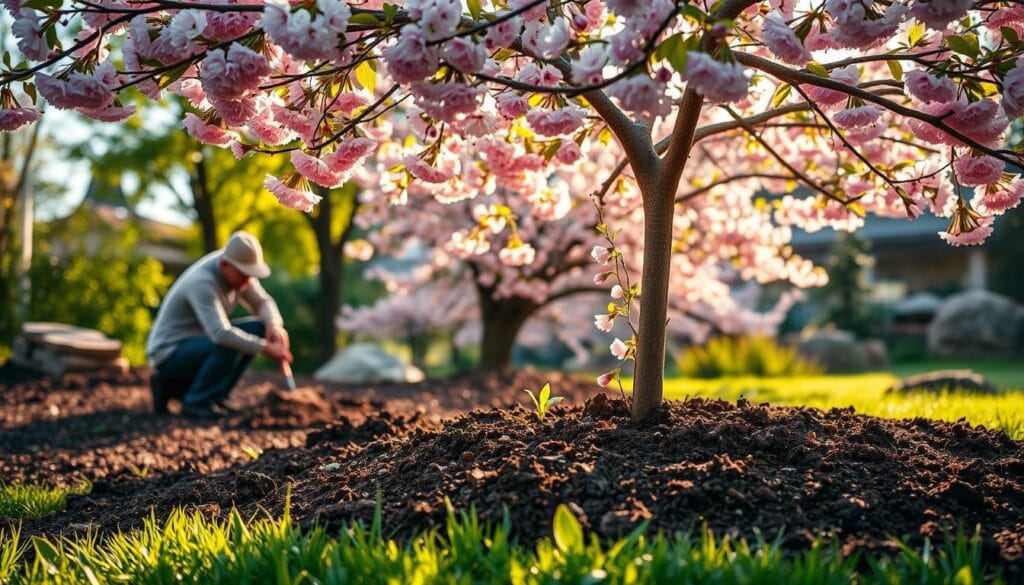
For planting, I dig a hole twice as wide as the root ball. I mix compost into the soil for better growth. It’s important to keep the root collar level with the soil surface13.
After planting, I water well and add 2-3 inches of organic mulch around the base. I make sure to avoid the trunk13.
Container gardening is also a great option for these trees. I use pots that are at least 18-24 inches in diameter with good potting soil13. This is perfect for small spaces or patios, offering a brief but beautiful spring bloom11.
| Planting Method | Spacing | Best Time to Plant |
|---|---|---|
| In-ground | 20-30 feet apart | Early fall or spring |
| Container | Single tree per 18-24 inch pot | Early spring |
These ornamental cherry trees live for 15 to 20 years. Proper planting is key for years of enjoyment11. With the right care, your Japanese flowering cherry will be a beautiful centerpiece in your garden.
Watering and Irrigation Needs
Proper irrigation is key for Japanese flowering cherry trees. They need about an inch of water each week. Young trees need more water, while older ones can handle less.
Frequency of Watering
I water my young cherry trees every week. During dry times, I do it twice a week. For older trees, I water them every two weeks. This keeps them moist without too much water.
Moisture Retention Techniques
To keep the soil moist, I use mulch. A 2-3 inch layer helps keep moisture in and keeps the soil cool. It’s great for keeping the soil moist.
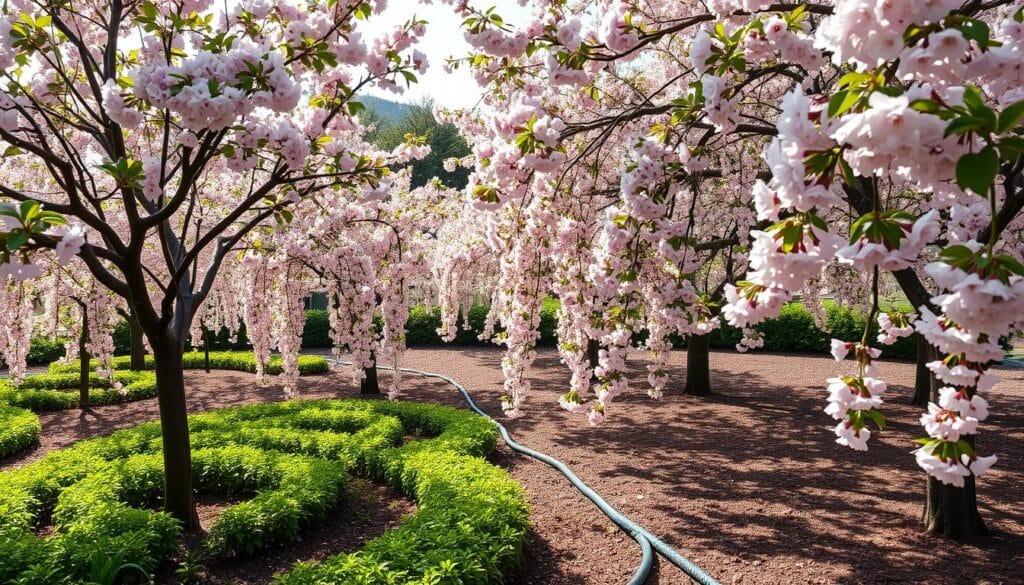
Avoiding Overwatering Issues
Too much water can harm your trees as much as too little. I make sure the soil isn’t waterlogged to avoid root rot. I water slowly and deeply to help the roots grow strong and prevent water from pooling on the surface.
| Tree Age | Watering Frequency | Amount |
|---|---|---|
| Young (1-3 years) | Weekly | 1 inch |
| Established (3+ years) | Bi-weekly | 1 inch |
| During Drought | Twice Weekly | 1-2 inches |
Remember, flowering cherries like well-draining soil with a pH of 6.0 to 7.5. They need soil that’s consistently moist14. By following these watering tips, your Japanese flowering cherry will bloom beautifully every year.
Fertilization and Soil Management
Proper nutrient management is key to growing healthy Japanese flowering cherry trees. These trees do best in fertile soils with a pH between 6.0 and 7.515. I regularly test my soil and adjust it as needed to keep it at the ideal pH.
I use a slow-release fertilizer specifically for cherry trees. I apply it in spring, making sure not to overdo it. Too much fertilizer can harm the blossoms we all love.
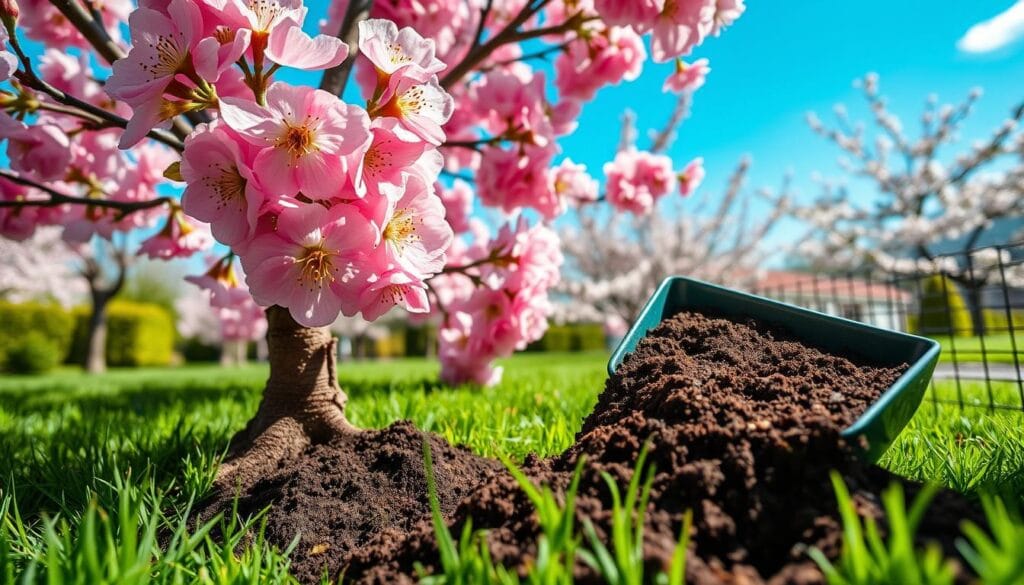
For organic fertilization, I mix compost into the soil when planting and top-dress it sometimes. This natural method improves soil structure and provides nutrients. I also keep mulch 6 inches away from the tree base15.
Soil management is more than just fertilizer. These trees prefer well-drained soil and can handle some drought16. I make sure the soil drains well and water deeply during dry times. With proper care, your Japanese flowering cherry can live for 20-25 years15.
Pruning and Shaping Techniques
Pruning Japanese Flowering Cherry trees is an art that needs careful timing and technique. The best time for major pruning is at the start of spring. Smaller trims can be done after blooming17. This way, you maximize bloom potential and keep the tree healthy.
Best Time for Pruning
Late winter to early spring is the best time for most pruning tasks18. But, post-flowering pruning is key for more blooms. Missing this window means the tree will focus on next year’s buds.
Pruning Methods for Optimal Growth
For the best growth, I mix thinning and heading cuts18. Thinning lets more light in and improves air flow, making blooms better19. But, don’t over-prune, as it can make foliage sparse and reduce flowers18.
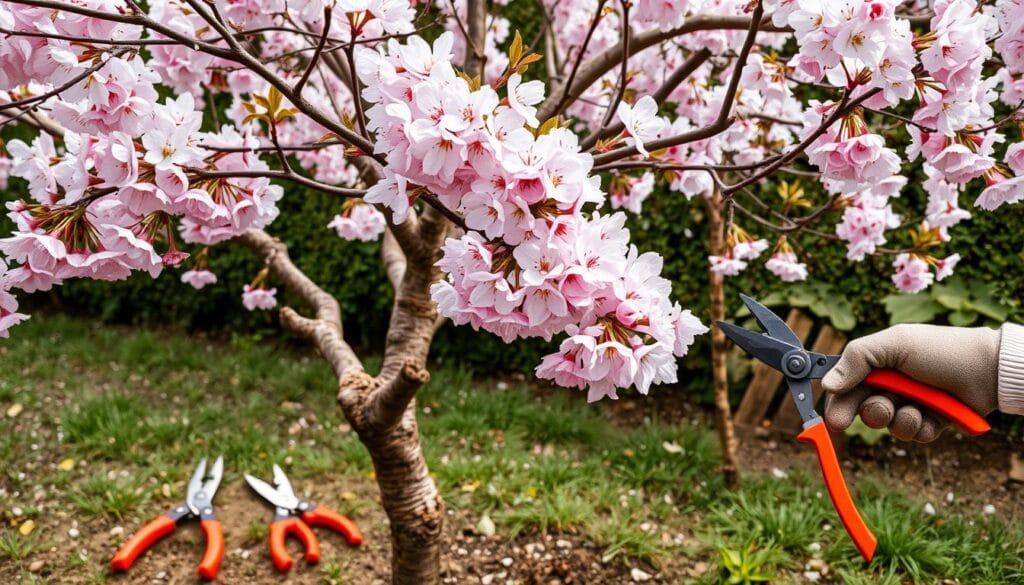
Shaping for Aesthetic Appeal
Shaping these trees for beauty means choosing which branches to cut. This lets each bloom show off19. Regular deadheading during blooming keeps flowers coming1918. Remember, each cherry blossom type needs its own pruning plan.
To keep the tree healthy, I clean my tools with bleach and water before and after pruning17. Also, dispose of pruned branches from diseased areas to stop diseases like Black Knot and Silver Leaf Fungus17. By using these pruning and shaping methods, your Japanese Flowering Cherry will be a beautiful garden centerpiece.
Common Pests and Diseases
Japanese flowering cherry trees face many challenges. They are often attacked by pests and diseases. Keeping them healthy is key to their long life.
These trees can get sick from fungi. Black knot and brown rot are common problems. Cherry leaf spot also affects them, especially in late May and early June20.
It’s important to watch for these issues all season. This way, you can catch problems early.
Controlling pests is also crucial. Spider mites and scale insects can harm these trees. Scale insects need horticultural oil to treat them. To fight pests like fungus gnats and fruit flies, keep the soil dry and use yellow sticky traps21.
Keeping trees healthy is the first step in preventing diseases. Fertilize them well and plant in good soil. Prune dead branches to keep them healthy21.
For organic pest control, neem oil and insecticidal soaps work well. Encourage good bugs like ladybugs and lacewings. Always wear protective gear when using pesticides21.
With the right care, your Japanese flowering cherry trees will thrive. They will stay healthy and look great.
Popular Cultivars of Japanese Flowering Cherry
Japanese Flowering Cherry (Prunus serrulata) is a favorite ornamental tree. It’s loved for its beautiful blossoms and elegant shape. I’ve looked into some top cherry blossom varieties that gardeners and landscapers love.
‘Kanzan’ Variety
The ‘Kanzan’ cultivar is a standout. It has deep pink double blossoms that are stunning. This tree can grow up to 30 feet tall, making it a beautiful garden centerpiece. ‘Kanzan’ is famous for its large flowers, often with up to 28 petals22.
‘Shirotae’ Variety
‘Shirotae’, also known as Mount Fuji cherry, is breathtaking. It has clusters of white, fragrant flowers that cover the tree. This variety grows to about 20 feet tall, with slightly arching branches22.
‘Kiku-shidare’ Variety
The ‘Kiku-shidare’ variety, also called Cheal’s weeping cherry, is unique. It has rich pink double blossoms on cascading branches, reaching about 15 feet tall and wide. Its weeping form adds drama to landscapes.
Other notable cherry blossom varieties include ‘Accolade’, released in 1952, and ‘Snow Goose’, a recent addition22. The ‘Ukon’ cultivar is interesting, with large, semidouble flowers in a yellowish or pale green color22.
| Cultivar | Flower Color | Height | Unique Feature |
|---|---|---|---|
| Kanzan | Deep Pink | 30 feet | Up to 28 petals per blossom |
| Shirotae | White | 20 feet | Fragrant flowers |
| Kiku-shidare | Rich Pink | 15 feet | Weeping form |
| Ukon | Yellowish-Green | Varies | Unique flower color |
These ornamental cherry cultivars come in various colors, sizes, and forms. They let gardeners pick the perfect variety for their landscape needs and tastes.
Propagation Methods for Prunus serrulata
Propagating Japanese Flowering Cherry trees is rewarding. Spring is the best time for this, with the right conditions for success23. Let’s look at some effective ways to propagate cherry trees.
Grafting is a favorite for Prunus serrulata. It works best in spring, creating a strong bond between the scion and rootstock23. This method is great for keeping the special traits of the parent tree.
Using cuttings is another good option. Hardwood cuttings should be 4 to 8 inches long with several buds23. Softwood cuttings, taken in late spring or early summer, are easier to root and take two to three months to develop roots2324.
Air layering is an interesting method I’ve tried. It involves making a root ball on a branch while it’s still on the parent tree. This method can be tricky but can give great results.
| Propagation Method | Best Time | Success Rate | Difficulty Level |
|---|---|---|---|
| Grafting | Spring | High | Moderate |
| Softwood Cuttings | Late Spring/Early Summer | Moderate | Easy |
| Air Layering | Spring | Moderate | Difficult |
While propagating cherries from cuttings is often seen as the easiest way, some varieties like the Japanese Flowering Cherry can be tough24. In my experience, patience and proper care are crucial for success, no matter the method chosen.
Seasonal Care and Maintenance
I’ve learned that Japanese flowering cherry trees need care all year to stay healthy and beautiful. In spring, I start with fertilizing and checking for pests. These trees love to eat, so they need regular food14. I water them deeply, giving 1-2 inches per week, using soaker hoses for better water use25.
Summer care includes watering and keeping mulch in check. I make sure the soil is moist but not too wet. Mulching helps keep moisture in and keeps the soil cool25. In fall, I clean up fallen leaves to stop diseases from spreading.
Winter protection depends on where you live. In cold areas, I add extra mulch around young trees. Pruning is best in late winter or early spring, before new growth starts14. This helps avoid fungal problems that can come from pruning at the wrong time.
Spring maintenance is key. I watch for winter damage and fix it quickly. It’s also time to fertilize, preparing for healthy growth and beautiful flowers25. By adjusting care based on the local climate, my cherry trees do well all year25.
“Caring for Japanese flowering cherries is a year-round commitment, but the breathtaking spring display makes it all worthwhile.”
Incorporating Japanese Flowering Cherry in Landscape Design
Japanese flowering cherry trees add beauty and renewal to any garden. They can turn a simple garden into a stunning place, bringing peace to outdoor areas26.
Complementary plantings
When adding cherry trees, mix different heights for a layered look26. Knowing when they bloom is key for a great garden27. Pair them with spring bulbs or woodland plants for a year-round display.
Using as focal points in gardens
These trees grow 15 to 25 feet tall, perfect for garden highlights27. They work well as standalone trees or in mixed borders. For bigger spaces, choose larger varieties26. Place them to create shaded areas for relaxation and gatherings.
Container growing options
In small spaces, go for compact cherry tree varieties26. Container gardening is great for patios or near doors. Use big pots with good drainage and quality soil. Place them in sunny spots for the best bloom.
For these trees to thrive, they need well-drained soil and deep water27. Adding them to your garden design makes a beautiful, peaceful outdoor space that honors nature’s beauty.
Conclusion
I’ve grown to love the Japanese flowering cherry tree. It’s a true wonder of nature. Its beauty is unmatched, turning any landscape into a stunning sight in spring. These trees can reach up to 12-15 meters tall, with flowers in clusters of 2-5 on short stalks, each blossom up to 5cm in diameter28.
The japanese flowering cherry care is all about knowing its special needs and how it grows.
The history of Prunus serrulata is captivating. In Japan, people have grown these trees since the 14th century. This helped start the flower viewing culture29. This tradition then moved to Europe and the United States in the early 1900s, after Japan gave trees to the U.S. in 191229.
Holding feasts under blooming cherry trees, known as Hanami, has been a beloved tradition in Japan for centuries29.
Caring for these trees needs some work, but the reward is huge. They do best in USDA zones 5-8 and come in many varieties. Each variety has its own flower color, shape, and size28. For example, ‘Kanzan’ has flowers with 20 to 50 petals, showing the wide range of beauty these trees offer29.
With the right care and quick action on any problems, anyone can enjoy the fleeting beauty of Japanese flowering cherry trees for many years.
FAQ
What is the ideal climate for growing Japanese flowering cherry trees?
How much sunlight do Japanese flowering cherry trees need?
What soil conditions are best for growing Japanese flowering cherries?
How often should I water my Japanese flowering cherry tree?
When is the best time to prune Japanese flowering cherry trees?
What are some common pests and diseases that affect Japanese flowering cherries?
Can Japanese flowering cherry trees be grown in containers?
What are some popular cultivars of Japanese flowering cherry?
How can I propagate Japanese flowering cherry trees?
Source Links
- Types of Trees – Cherry Blossom Festival (U.S. National Park Service)
- Flowering Cherry’s
- Care guide for the Cherry Bonsai tree (Prunus) – Bonsai Empire
- History of the Cherry Trees – Cherry Blossom Festival (U.S. National Park Service)
- Japanese Flowering Cherries —A 100-Year-Long Love Affair
- Prunus serrulata
- Prunus serrulata (Japanese Cherry, Japanese Flowering Cherry, Oriental Cherry)
- The best cherry blossom trees for your garden
- Best Soil for Japanese Flowering Cherry
- Flowering cherry tree care and growing guide – expert tips for these spring blossom favorites
- How to Grow a Japanese Flowering Cherry Tree
- How To Grow And Care For Cherry Blossom Trees
- 🌸 How to Plant Your Japanese Flowering Cherry
- How to Grow and Care for Flowering Cherry Trees
- Ornamental Cherry Trees: Identify and Manage Problems
- How to Prune a Cherry Blossom Tree – Primrose Garden Club | Expert Tips, Advice & Inspiration
- When and Where to Cut Back Your Cherry Blossom Tree 🌸
- How to Prune Japanese Flowering Cherry
- 7 Common Cherry Tree Diseases and How to Treat Them
- What Are The Bugs on My Japanese Flowering Cherry?
- Flowering Cherry Collection – Brooklyn Botanic Garden
- 🌸 Propagating My Japanese Flowering Cherry: Step-by-Step Guide
- Propagating Cherry Blossom Cuttings
- 5 Outdoor Care Tips for Japanese Flowering Cherry 🌸
- 8 Japanese Flowering Cherry Landscaping Hacks 🌸
- Japanese Flowering Cherry: Not an Annual 🍒
- Prunus Serrulata — Earthpedia plant
- Cherry blossom

